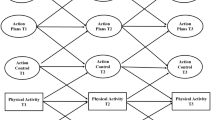Abstract
Research attempting to elucidate physical activity (PA) intention-behavior relations has focused on differences in long-term behavior forecasting between people. However, regular PA requires a repeated performance on a daily or within-daily basis. An empirical case study application is presented using intensive longitudinal data from a study of PA in adults to (a) describe the extent to which short-term intention-behavior coupling occurs and (b) explore time-varying predictors of intention formation and short-term intention-behavior coupling. Adults (n = 116) participated in three 4-day waves of ecological momentary assessment (EMA). Each day, participants received EMA questionnaires assessing short-term PA intentions and wore accelerometers to assess whether they engaged in ≥10 min of moderate-to-vigorous physical activity (MVPA) in the 3-hour period after each EMA prompt. Concurrent affective states and contexts were also assessed through EMA. Participants reported having short-term intentions to engage in PA in 41% of EMA prompts. However, participants only engaged in ≥10 min of MVPA following 16% of the prompts that short-term PA intentions were reported indicating an intention-behavior gap of 84%. Odds of intentions followed by PA were greater on occasions when individuals reported higher levels of positive affect than was typical for them. This study is the first to take an EMA approach to describe short-term intention-behavior coupling in adults. Results suggest that adults have difficulty translating intentions into behavior at the momentary level, more so than over longer timescales, and that positive affect may be a key to successfully translating intentions into behavior.
Similar content being viewed by others
References
Ajzen, I. (1991). The theory of planned behavior. Organ Behav Hum Decis Process, 50(2), 179–211.
Bandura, A. (1986). Social foundations of thought and action: A social cognitive theory (Vol. xiii). Englewood Cliffs, NJ: Prentice Hall.
McEachan, R. R. C., Conner, M., Taylor, N. J., & Lawton, R. J. (2011). Prospective prediction of health-related behaviours with the theory of planned behaviour: a meta-analysis. Health Psychology Review, 5(2), 97–144. doi:10.1080/17437199.2010.521684.
Rhodes, R. E., & Dickau, L. (2012). Experimental evidence for the intention–behavior relationship in the physical activity domain: a meta-analysis. Health Psychol, 31(6), 724–727. doi:10.1037/a0027290.
Rhodes, R. E., & de Bruijn, G. J. (2013). What predicts intention-behavior discordance? A review of the action control framework. Exerc Sport Sci Rev, 41(4), 201–207.
Rhodes, R. E., & Dickau, L. (2012). Moderators of the intention-behaviour relationship in the physical activity domain: a systematic review. Br J Sports Med, 47(4), 215–225. doi:10.1136/bnsports-2011-090411.
Rhodes, R. E., & de Bruijn, G. J. (2013). How big is the physical activity intention–behaviour gap? A meta-analysis using the action control framework. Br J Health Psychol, 18(2), 296–309.
Physical Activity Guidelines Advisory Committee. (2008). Physical activity guidelines advisory committee report, 2008 (pp. A1–H14). Washington, DC: U.S. Department of Health and Human Services.
Liao, Y., Intille, S., & Dunton, G. F. (2015). Using ecological momentary assessment to understand where and with whom adults’ physical and sedentary activity occur. International journal of behavioral medicine, 22(1), 51–61.
Schwarz, N. (2007). Retrospective and concurrent self-reports: the rationale for real-time data capture. In A. A. Stone, S. Shiffman, A. A. Atienza, & L. Nebeling (Eds.), The science of real-time data capture: self-reports in health research (pp. 11–26). New York, NY: Oxford University Press.
Conroy, D. E., Elavsky, S., Doerksen, S. E., & Maher, J. P. (2013). A daily process analysis of intentions and physical activity in college students. Journal of Sport & Exercise Psychology, 35(5), 493–502.
Conroy, D. E., Elavsky, S., Hyde, A. L., & Doerksen, S. E. (2011). The dynamic nature of physical activity intentions: a within-person perspective on intention-behavior coupling. Journal of Sport & Exercise Psychology, 33(6), 807–827.
Pickering, T. A., Huh, J., Intille, S., Liao, Y., Pentz, M. A., & Dunton, G. F. (2016). Physical activity and variation in momentary behavioral cognitions: an ecological momentary assessment study. J Phys Act Health, 13(3), 344–351.
de Bruijn, G. J. (2011). Exercise habit strength, planning and the theory of planned behaviour: an action control approach. Psychol Sport Exerc, 12(2), 106–114.
de Bruijn, G. J., Verkooijen, K., de Vries, N. K., & van den Putte, B. (2012). Antecedents of self identity and consequences for action control: an application of the theory of planned behaviour in the exercise domain. Psychol Sport Exerc, 13(6), 771–778.
Godin, G., Shephard, R. J., & Colantonio, A. (1986). The cognitive profile of those who intend to exercise but do not. Public Health Rep, 101(5), 521–526.
Reed, G. R., Velicer, W. F., Prochaska, J. O., Rossi, J. S., & Marcus, B. H. (1997). What makes a good staging algorithm: examples from regular exercise. Am J Health Promot, 12(1), 57–66.
Ajzen, I., & Fishbein, M. (1980). Understanding attitudes and predicting social behaviour. Englewood Cliffs, NJ: Prentice Hall Retrieved from http://www.citeulike.org/group/38/article/235626.
Troiano, R. P., Berrigan, D., Dodd, K. W., Masse, L. C., Tilert, T., & McDowell, M. (2008). Physical activity in the United States measured by accelerometer. Med Sci Sports Exerc, 40(1), 181–188.
Dunton, G. F., Liao, Y., Intille, S., Huh, J., & Leventhal, A. (2015). Momentary assessment of contextual influences on affective response during physical activity. Health Psychol, 34(12), 1145–1153.
Rhodes, R. E., Plotnikoff, R. C., & Courneya, K. S. (2008). Predicting the physical activity intention–behavior profiles of adopters and maintainers using three social cognition models. Ann Behav Med, 36(3), 244–252.
Hedeker, D., Mermelstein, R. J., & Demirtas, H. (2012). Modeling between-subject and within-subject variances in ecological momentary assessment data using mixed-effects location scale models. Stat Med, 31(27), 3328–3336.
Curran, P. J., & Bauer, D. J. (2011). The disaggregation of within-person and between-person effects in longitudinal models of change. Annu Rev Psychol, 62, 583–619.
Muraven, M., Tice, D. M., & Baumeister, R. F. (1998). Self-control as a limited resource: regulatory depletion patterns. J Pers Soc Psychol, 74(3), 774–789. doi:10.1037/0022-3514.74.3.774.
Maher, J. P., Dzubur, E., Huh, J., Intille, S., & Dunton, G. F. (2016). Within-day time-varying associations between behavioral cognitions and physical activity in adults. Journal of Sport and Exercise Psychology.
Inauen, J., Stadler, G., Scholz, U., Shrout, P., & Bolger, N. (2015). The dynamics and relations of intentions and behavior in everyday life. In Presented at the 4th Biennial Society of Ambulatory Assessment Conference. Park, PA: University.
Liao, Y., Shonkoff, E. T., & Dunton, G. F. (2015). The acute relationships between affect, physical feeling states, and physical activity in daily life: a review of current evidence. Front Psychol, 6. doi:10.3389/fpsyg.2015.01975.
Hufford, M. R. (2007). Special methodological challenges and opportunities in ecological momentary assessment. In A. A. Stone, S. Shiffman, A. A. Atienza, & L. Nebeling (Eds.), The science of real-time data capture: Self-reports in health research (pp. 54–75).
Dunton, G. F., Liao, Y., Kawabata, K., & Intille, S. (2012). Momentary assessment of adults’ physical activity and sedentary behavior: feasibility and validity. Front Psychol, 3. doi:10.3389/fpsyg.2012.00260.
Ham, S. A., Kruger, J., & Tudor-Locke, C. (2009). Participation by US adults in sports, exercise, and recreational physical activities. J Phys Act Health, 6(1), 6–14.
Kumar, S., Nilsen, W., Pavel, M., & Srivastava, M. (2013). Mobile health: revolutionizing healthcare through transdisciplinary research. Computer, 46(1), 28–35. doi:10.1109/MC.2012.392.
Riley, W. T., Serrano, K. J., Nilsen, W., & Atienza, A. A. (2015). Mobile and wireless technologies in health behavior and the potential for intensively adaptive interventions. Current Opinion in Psycholoy, 5, 67–71.
Rivera, D. E., Pew, M. D., & Collins, L. M. (2007). Using engineering control principles to inform the design of adaptive interventions: a conceptual introduction. Drug and Alcohol Dependence, 88. Supplement, 2, S31–S40. doi:10.1016/j.drugalcdep.2006.10.020.
Author information
Authors and Affiliations
Corresponding author
Ethics declarations
This work has been submitted solely to TBM and has not been previously published, either in part or in whole, and the findings have not been posted online. The corresponding author has had access to all aspects of the research and writing process and assumes complete responsibility for the paper. All authors have control of the primary data and agree to allow the journal to review the data if requested. All authors agree with the form and content of the submitted manuscript and the ordering of the authorship. All procedures performed in studies involving human participants were in accordance with the ethical standards of the University of Southern California and with the 1964 Helsinki declaration and its later amendments or comparable ethical standards. Informed consent was obtained from all individual participants included in the study.
Conflict of interest
The authors declare that there are no conflicts of interest.
Funding
This research was supported by the American Cancer Society 118283-MRSGT-10-012-01-CPPB (Dunton, PI).
Additional information
Implications
Researchers: While time-varying factors such as affect and time of day contribute to short-term physical activity intention-behavior coupling, more research is needed to explore other time-varying factors including characteristics of the physical environment and self-regulation.
Practitioners: Healthcare providers should recognize that intentions will not always translate into behavior depending on the current context and encourage patients to study and recognize the contexts that are most conducive to following through with short-term physical activity intentions.
Policymakers: Resources should be directed towards novel methodological approaches designed to better understand the processes influencing health behaviors in the context of everyday life.
About this article
Cite this article
Maher, J.P., Rhodes, R.E., Dzubur, E. et al. Momentary assessment of physical activity intention-behavior coupling in adults. Behav. Med. Pract. Policy Res. 7, 709–718 (2017). https://doi.org/10.1007/s13142-017-0472-6
Published:
Issue Date:
DOI: https://doi.org/10.1007/s13142-017-0472-6




